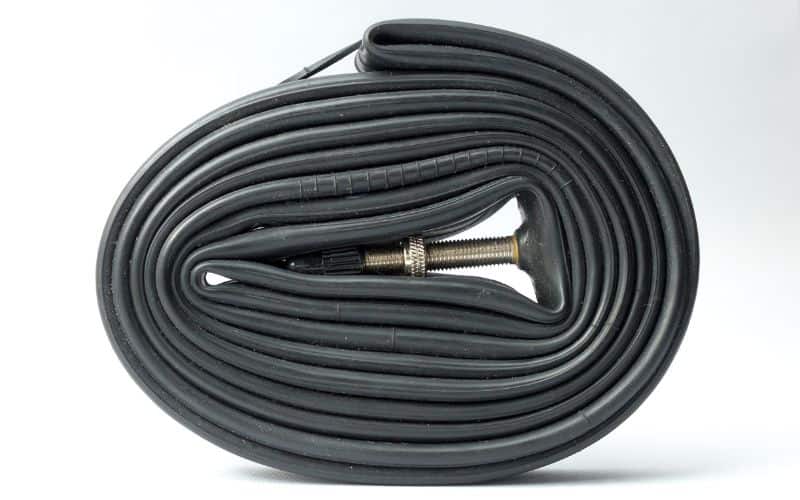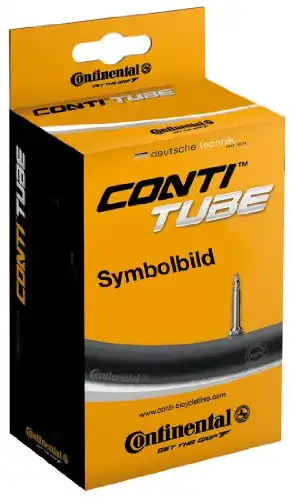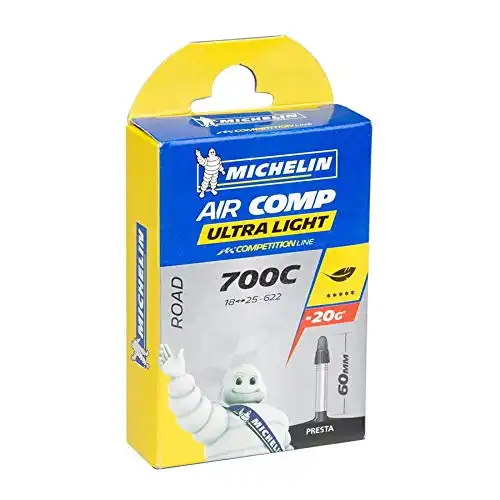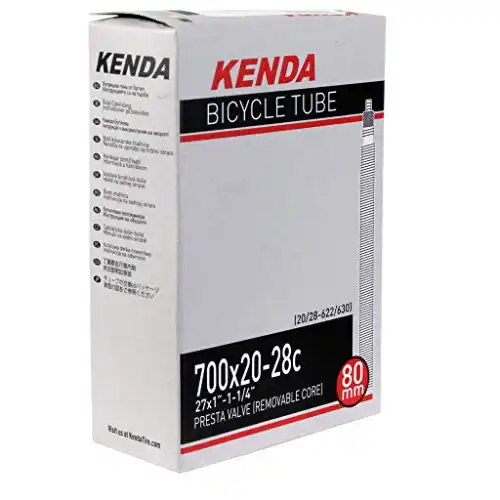If you’re like me, I don’t think much about my road bike inner tubes. When one needs replacing, I focus on price, not function. And yet, there are benefits to considering new, more expensive varieties, especially if you want to go faster or improve your ride’s feel.
In this article, I’ll share my top picks for the best road bike inner tubes, so you can make an informed decision and enjoy your rides to the fullest.
Inner Tubes: The Forgotten Child
After researching and testing various road bike inner tubes, I’ve identified the best options on the market. These inner tubes not only provide excellent puncture resistance but also offer a smooth and comfortable ride.
|
Pros:
|
Pros:
|
Pros:
|
- Lighter weight and lower rolling resistance
- Supple ride
- Puncture resistant
- Light-weight
- Resists puncturing
- Small size fits in a pack or jersey
- Lightweight design
- High-quality butyl material
- Easy to install
Reviews Of The Best Road Bike Inner Tubes
Vittoria PV/Latex Road Tube
- Lighter weight and lower rolling resistance
- Supple ride
- Puncture resistant
- Pricey
The only latex tube to enter the fray is from Vittoria. I recently tried out the Vittoria PV/Latex Road Tube and was impressed with its difference in my ride.
These bike tubes are light (75g) and give better rolling resistance. They are also more puncture resistant because of their elasticity.
If you don’t like pink, remember, they’re inside the tire so no one will know!
The tubes tend to lose air faster than butyl tubes, so checking the pressure before every ride is essential. Another thing to note is that it only comes in one valve length (48mm). However, it has a removable valve core allowing an extender to be added for aero wheels.
Suppose you’re looking for a road bike inner tube that provides a smoother, more comfortable ride. In that case, the Vittoria PV/Latex Road Tube is a great option.
Tubolito Tubo Road 700c
- Light-weight
- Resists puncturing
- Small size fits in a pack or jersey
- Expensive; twice as much as butyl bike tubes
- Plastic stem; prone to breaking
- Requires Tubolito patch kit for repairing flats
The manufacturer touts these orange gems made from TPU (thermoplastic elastomer) to be two-thirds lighter, two times more puncture-resistant, and half the size of regular butyl bike tubes. Do they live up to these claims?
The weight savings are definitely noticeable. The smaller packed size also makes carrying a spare on long rides easy. The tube also seems more durable than other lightweight options I’ve tried, as it passed the puncture test with flying colors.
However, the plastic valve stem can deform over time. This makes it difficult to attach a pump or inflate the tube. Additionally, while the Tubolito Road Tubo is more puncture-resistant than other lightweight tubes, it’s not impervious to punctures.
Finally, at its price point, it’s definitely a premium option compared to other inner tubes on the market.
Overall, if you’re looking for a lightweight and durable inner tube for your road bike and are okay with spending more, the Tubolito Road Tubo is an excellent choice.
Continental Supersonic Road Inner Tube
- Lightweight design
- High-quality butyl material
- Easy to install
- Reduced wall thickness increases the risk of punctures
- Lightweight tubes must be pumped more frequently
- More expensive than standard inner tubes
From a premier tire company comes a lightweight butyl tube. Continental is well-known for quality, so you know these tubes underwent a rigorous inspection process before going to market.
Installation was a breeze, and the tubes fit perfectly on my 700c wheels. I also appreciated that these tubes could be fixed with a standard puncture kit. Standard saddle bag repair kits are fine.
One thing to remember is that the reduced wall thickness of these tubes increases the risk of punctures. So, they may not be the best choice for riders who frequently encounter rough terrain or debris on the road.
Additionally, lightweight tubes must be pumped more frequently, so you must monitor tire pressure to ensure optimal performance.
Michelin AirComp Ultra Light
- Moderately priced
- Lightweight design doesn't add much weight to your bike
- Various stem lengths
- Smooth valve stem may not suit all cyclists
- Not suitable for wider tires
I’ve used Michelin’s tube for a few months now and found it a decent option for road biking. The butyl rubber material provides durability and has held up well against punctures. The longer valve is a nice feature for those with aero rims, allowing for easier inflation.
If you don’t require that long of a stem, Michelin offers this bike inner tube with 40 and 52-mm stem that weigh 75g. The Michelin AirComp with the 60mm valves weighs 80g.
Some users have reported issues with the valve stem, so it’s important to be careful when inflating the tube. Additionally, this tube is unsuitable for wider tires, so check your tire size before purchasing.
Kenda Bicycle Tube
- Moderately priced
- Good quality - durable and long-lasting
- Fits deep-section wheels
- Not the lightest; 113 g
The tube is made of high-quality butyl rubber and has proven very durable. It has held up well against punctures and leaks, which is a big plus as I often ride on rough roads.
One of the things I like about this tube is how easy it is to install. It fits snugly into the tire and has a Presta valve that is easy to use. It’s also compatible with deep-section wheels, which is a big plus for those with this type of setup.
However, one downside of this tube is that it’s slightly heavier than other tubes in this roundup. This may not be a big deal for some, but it’s worth noting if you want to shave off some weight from your bike.
Kenda offers a smooth valve with a 32, 48, 60, and 80mm long stem.
What To Look For In Road Bike Inner Tubes
Let’s break down what’s essential when buying new bike inner tubes. If you need help fixing a flat tire, check out our guide on maintaining your bike here.
Size
The first thing to consider is the size of the inner tube.
You want to make sure you get the right size for your bike’s tire. The size is usually marked on the tire and will look something like “700x25c”.
The first number (700) is the tire’s diameter in millimeters, and the second (25) is the width in millimeters. Make sure you get an inner tube that matches these numbers.
Valve Type
The next thing to consider is the valve type.
There are two main types of valves: Presta and Schrader.
Presta valves are thinner and typically found on higher-end bikes. Schrader valves are thicker and more commonly found on entry-level bikes. Ensure you get an inner tube with the correct valve type for your bike.
The Materials
To date, there are three materials used to make road bike inner tubes:
- Butyl
- Latex
- Polyurethane and TPU (thermoplastic elastomer)
Butyl Bike Tubes
Butyl bike tubes are made from synthetic, black rubber, which most of us use. It’s more than likely what came with your bike, which means it weighs about 100-110g.
Experts recommend using butyl bike tubes for carbon fiber wheels since they heat up more (with rim brakes) than aluminum rims and are thus prone to blowouts. Conversely, if you have carbon wheels with disc brakes, then the point is moot.
Latex Bike Tubes
Latex bike tubes are made from the sap of rubber trees. Because they are more labor-intensive to manufacture, they are more expensive than butyl bike tubes.
Latex tubes are naturally porous, so they lose air and must be pumped daily.
A concern other cyclists reported were that they could blow out with no warning. If you use rim brakes and use them heavily on long descents, the heated rim could cause the latex tube to blow.
However, if your bike has disc brakes (which heat up, not the rims), you won’t have to worry about this as much.
TPU Tubes
The new kid on the block is road bike inner tubes made from polyurethane like Aerothan, thermoplastic elastomers, or TPU (like the Tubolito Road Tubo). The Aerothan bike tubes are made of non-rubber polyurethane polymer and were developed by BASF.
Here is an informative video explaining the pros and cons of these tubes:
Stem Lengths
When purchasing bike inner tubes, ensure you get one with the correct stem. Most road bikes use a Presta valve. Some MTB or beach cruisers use the Schrader valve.
Be sure to get a stem that is the correct length for your rim type. If you’re uncertain, take your bike to your LBS (local bike shop), and they can help determine what size you need.
Some valves are threaded and include a nut to secure them to the rim. Others are smooth and nut-less. Some cyclists claim the smooth stem is easier on their pumps than the threaded variety. This comes down to personal taste.
Sick of having to change your tubes constantly? Check out our comparison against tubeless tires.

Frequently Asked Questions
Are There Eco-Friendly Road Bike Inner Tube Options?
We haven’t tested these, but the Schwable Aerothan Road Tube is a good option for eco-friendly inner tubes. It combines performance with environmentally conscious manufacturing processes.
Is It True That Inner Tubes Can Affect Rolling Resistance?
Yes, the type of inner tube can indeed affect rolling resistance.
For instance, tubes made from natural latex rubber have been the choice of fast riders for many decades due to their lower rolling resistance, which can make your bike faster.
How Does The Quality Of Inner Tubes Impact Bike Performance?
The quality of an inner tube can significantly affect your bike’s performance.
Good inner tubes do more than just hold air in your tires – they can make your bike faster, lighter, and more reliable by preventing punctures.
Choosing the best inner tubes is a cost-effective way to enhance certain aspects of your bike’s performance. Read our guide on checking if your inner tube has gone bad.
How Often Should I Replace My Road Bike Inner Tubes?
The frequency of replacement depends on various factors, including the quality of the tube, the conditions in which you ride, and how well the tube is maintained.
A good-quality tube like the Kenda tube can last 500 to 1,000 miles before it starts to wear off. However, carrying a spare inner tube in your saddle bag is always a good idea to be prepared for any eventualities.






